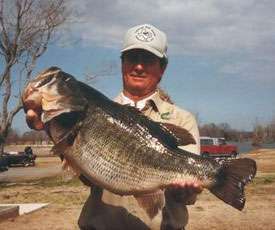Lake Fork Fishing
category : Fishing
 Lake Fork was created as a textbook fishery, including initial stockings before the lake filled. Lake Fork was established, by the Texas Parks and Wildlife, as a premier bass fishing lake, with 732,514 Florida Black Bass being stocked from 1979 through 1987. Lake Fork offers excellent fish habitat with 80% standing timber left intact, and hydrilla, milfoil, and duckweed being the predominant vegetation. Other species of fish include Catfish, Black and White Crappie, Sunfish, and Bluegill. The predominant food source for the larger fish is Shad, Minnows, and Crawfish.
Lake Fork was created as a textbook fishery, including initial stockings before the lake filled. Lake Fork was established, by the Texas Parks and Wildlife, as a premier bass fishing lake, with 732,514 Florida Black Bass being stocked from 1979 through 1987. Lake Fork offers excellent fish habitat with 80% standing timber left intact, and hydrilla, milfoil, and duckweed being the predominant vegetation. Other species of fish include Catfish, Black and White Crappie, Sunfish, and Bluegill. The predominant food source for the larger fish is Shad, Minnows, and Crawfish.Largemouth bass are the most popular sportfish in this 28,000 acre reservoir. A combination of restrictive harvest regulations, stocking of Florida strain largemouth bass, and good habitat has contributed to Lake Fork's development as one of the country's premier trophy bass lakes. More than 65% of the Texas Top 50 largest bass (including the current state record) and more than half of those entered in the Budweiser ShareLunker Program, were caught from Lake Fork. Crappie fishing is generally good, especially in standing timber and under the lake's numerous bridges. Channel catfish provide an excellent sport fishery, though this remains a well-kept secret. Sunfish, primarily bluegill, offer additional angling opportunities during spring and summer.
Fishing Cover/Structure
Flooded timber is found throughout Lake Fork and provides excellent fish habitat. Although access through the reservoir is provided by numerous buoyed boat lanes, submerged timber represents a substantial hazard, so care should be exercised while boating in all areas. Areas containing hydrilla, boat houses and docks, and lake points have historically provided some of the best fishing for largemouth bass.
Largemouth bass anglers are most successful on this reservoir during the spring, fall, and winter months. Spinnerbaits, plastic worms and lizards, jigs and jerk baits are all popular baits during peak fishing in the spring (mid-February to April) when fishing is concentrated along the shoreline for spawning fish. Nightime fishing during the hot summer months can be very productive and a good way to beat the Texas heat. At this time, plastic worms, spinnerbaits, crankbaits and topwaters are often used. During late summer and early fall, when fish are schooling, crankbaits and topwater lures can be very effective. In winter jigging spoons, jigs and crankbaits are most productive.
Crappie anglers concentrate their efforts in deep water near the dam during the winter months. In late spring and early fall, most angler fish for crappie under the bridges (Highway 154, Highway 515, CR 2946 and CR 514). Live minnows and crappie jigs are among the most popular baits used. The catfish population is dominated by channel catfish, but also includes flathead cats. Stinkbait and cutbait work well for channel cats, while live bait is preferred for flatheads. Anglers occasionally catch large blue catfish.
Sunfish such as bluegill and redear can be caught in early summer, in shallow water, using crickets, earthworms and small spinners. During the remainder of the year they can be caught using the same baits around piers, boathouses and submerged humps.
Address: Five miles west of Quitman and 15 miles south of Sulphur Springs.
Phone: 903-878-2262
Come visit us in Lake Fork, Texas